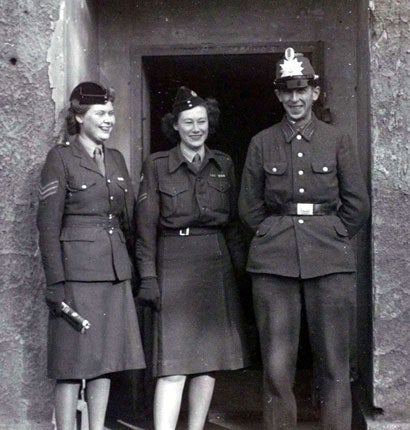Susan Hibbert: Secretary at Eisenhower's wartime headquarters

Susan Hibbert was witness to one of the most momentous events in the 20th century – the signing of the German surrender at the end of the Second World War on 7 May 1945.
As a 20-year-old British staff sergeant in the Auxiliary Territorial Service (ATS) her job was to type up the surrender documents.
She was not alone. Other women typed the French, German and Russian versions. As there had to be unanimous agreement, drafts were dispatched to the three allied capitals – London, Washington and Moscow. Obviously, perfection was required, and a mistake, or amendment, of which there were many, meant that the entire document had to be retyped. Over five days she witnessed the drama unfolding: there was little time for sleep or other necessities.
Hitler committed suicide on 30 April 1945, naming Grand Admiral Karl Dönitz as President of Germany. The one million German troops in Italy had surrendered the day before to Field Marshal Alexander; on 2 May, Berlin surrendered to the Soviets. Dönitz sent General Alfred Jodl to the headquarters of the Supreme Allied Commander, General Dwight D. Eisenhower, a small redbrick schoolhouse in Reims, to discuss terms.
The German President was attempting to buy time to enable as many German troops and civilians as possible to flee from the Russians. Eisenhower was, however, only prepared to accept the unconditional surrender of all German forces and Jodl reported this to Dönitz by radio early in the morning on 7 May. Eisenhower also insisted that the Germans signed on that day. The capitulation was to come into effect 48 hours later.
Jodl, with the authority of Dönitz, signed the unconditional surrender of all German forces on 7 May at 2.41am. For the Allies, the signatories were General Walter Bedell Smith, deputising for Eisenhower, and Major General Ivan Susloparov, deputising for the Soviet High Command. Major General François Sevez, as representative of General Charles de Gaulle's French forces, signed as a witness.
The most momentous wartime message typed by Hibbert simply read: "The mission of this Allied Force was fulfilled at 0241, local time, May 7th, 1945." For her work on Eisenhower's staff she was mentioned in dispatches.
Hibbert was born Susan Nona Heald in London on 21 May 1924. She was the daughter of L.F. Heald KC, and Flavia Forbes, whose parents were Lt.-Col. James Stewart Forbes and Angela Selina Blanca St. Clair-Erskine. Her parents divorced in 1928, when she was four, but she remained with her father. Her mother, who married three times, died in 1959 aged 56. Through her paternal grandmother, Henrietta Stewart Brown, she could trace her ancestry back to the 17th-century American religious reformer Anne Hutchinson, which meant that she was recognised as a Colonial Dame of America. She had other American ancestors as well.
Educated at the Godolphin School, Salisbury, she decided to go to secretarial college, completing a two-year course in nine months. As the daughter of a First World War veteran she wanted to do her bit for the war effort. In 1942, at the age of 18, she joined thousands of other women between the ages of 17 and 50 in the ATS. Attached to the Territorial Army, they served as clerks, cooks, drivers, storekeepers and orderlies. To begin with she had to wash up, rake camp fires and prepare messes at Aldermaston. Eventually she took a step up and was put to work handling highly classified documents.
Heald was sent to work at Eisenhower's headquarters, first at Bushy Park, Twickenham, later at Southwick House, Portsmouth and then in Versailles, where she lived in stables with her colleagues. Her American forebears and the fact that her father served with the rank of Air Commodore at General Eisenhower's Supreme Headquarters no doubt played a role in her selection.
After the German surrender, Heald worked at the Control Commission for Germany in Frankfurt am Main, in a division issuing licences to newspapers and information services. She shared a desk with the future press tycoon Captain Robert Maxwell, "who was horrible". She later served in Berlin, where she met and married Basil Hibbert, a former RAF pilot.
When her father was elected to the safe Conservative seat of Chertsey, Surrey in 1950, Hibbert worked as his secretary. As Rt. Hon. Sir Lionel Frederick Heald, QC, he served as Attorney-General in the Churchill government from 1951 to 1954. Hibbert remained at Westminster, working for him until his retirement in 1970. She then assisted other MPs, completing, in all, some 35 years of service. She continued working hard for the Conservative Party and hosted an annual barbecue in Abbotts Ann, Hampshire.
On 5 April 2005 she joined the French Minister of Defence, Michèle Alliot-Marie, Eisenhower's personal photographer, 88-year-old Albert Meserlin, and other veterans in a celebration at the old Reims HQ.
Hibbert's husband, who later became a director of John Lewis, died in 2001. They had no children. Her brother was Mervyn Heald, QC.
Susan Nona Heald, secretary: born London 21 May, 1924; married Basil Hibbert; died Salisbury, Hampshire 2 February 2009.
Join our commenting forum
Join thought-provoking conversations, follow other Independent readers and see their replies
Comments